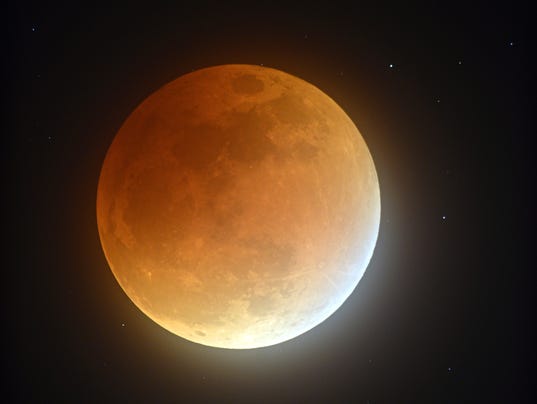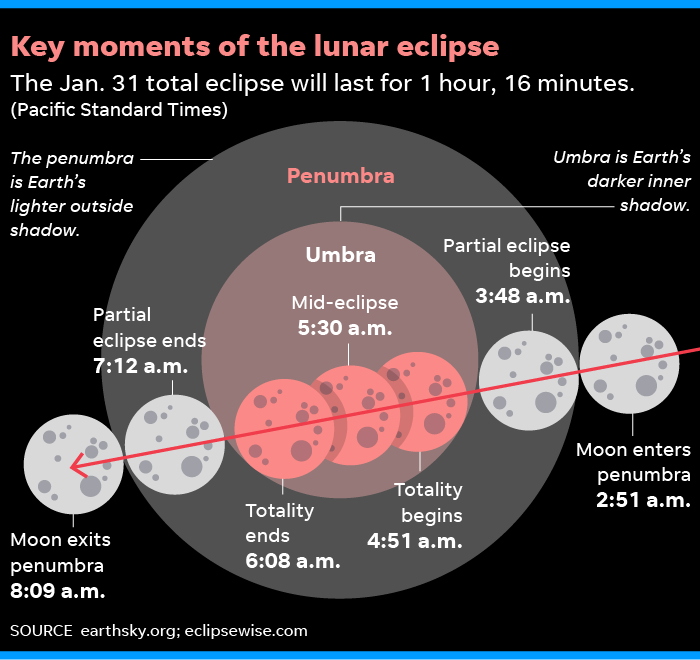Triple treat: Supermoon, blue moon and lunar eclipse all coming to a sky near you this week
Doyle Rice, USA TODAYThe full moon on January 31st will combine three rare lunar events for the first time in 150 years.

(Photo: Johnny Horne, The Fayetteville Observer via AP)
Skywatchers will get a rare triple treat early this Wednesday, Jan. 31: a supermoon, a blue moon and a total lunar eclipse.
How rare is the event? Even without the supermoon, it's the first blue moon total lunar eclipse in the U.S. since March 1866, less than a year after the Civil War ended, according to EarthSky.org.
A blue moon — which occurs about every 2½ years — is another term for the second full moon in a single calendar month. January's first full moon occurred Jan. 1.
“These three lunar events separately are not uncommon, but it is rare for all three to occur at the same time,” AccuWeather meteorologist and astronomy blogger Brian Lada said.
Though the exact moment of this full moon is 8:37 a.m. ET Jan. 31, the moon will appear plenty full for a day or two before and after that.
However, the moon doesn't actually appear blue.
As for the total lunar eclipse, it will be visible early in the morning of Jan. 31 from western North America across the Pacific to eastern Asia, NASA said.
In the United States, the best view of the eclipse will be along the West Coast. For skywatchers in the central and eastern U.S., only a partial eclipse will be visible since the moon will set before totality.
“The lunar eclipse on Jan. 31 will be visible during moonset," said Noah Petro, a research scientist from NASA’s Goddard Space Flight Center. "Folks in the eastern United States, where the eclipse will be partial, will have to get up in the morning to see it."
The eclipse will last almost 3½ hours from the beginning of the partial phase at 3:48 a.m. PT until it ends at 7:12 a.m. PT, according to Sky and Telescope. Totality lasts a generous 77 minutes, from 4:51 a.m. PT to 6:08 a.m. PT.
By that time, however, the moon will already have set in the eastern time zone.
As for the weather, clear skies are forecast across the eastern and south-central United States, according to AccuWeather.
Additionally, some astronomy historians can quibble about the origin of the "blue moon" name: It was originally a name for a season that had four full moons instead of three; a definition which was later mistakenly expanded to two full moons in a single month.
But even the venerable publication Sky & Telescope — in which the original "mistake" was made decades ago — said that "the second-full-moon-in-a-month (mis)interpretation is like a genie that can't be forced back into its bottle. But that's not necessarily a bad thing."

The full moon will take on a dark, reddish appearance during the eclipse, so another phrase used to describe it is a blood moon. Adding to the naming confusion, this full moon was also known as the "snow moon" by some Native American tribes.
Finally, a supermoon occurs when the full moon is at the closest point of its orbit to the Earth, which is also called the perigee.
That makes the moon look extra-close and extra bright — up to 14% bigger and 30% brighter than a full moon at its farthest point from Earth, known as the apogee, NASA said.
No comments:
Post a Comment